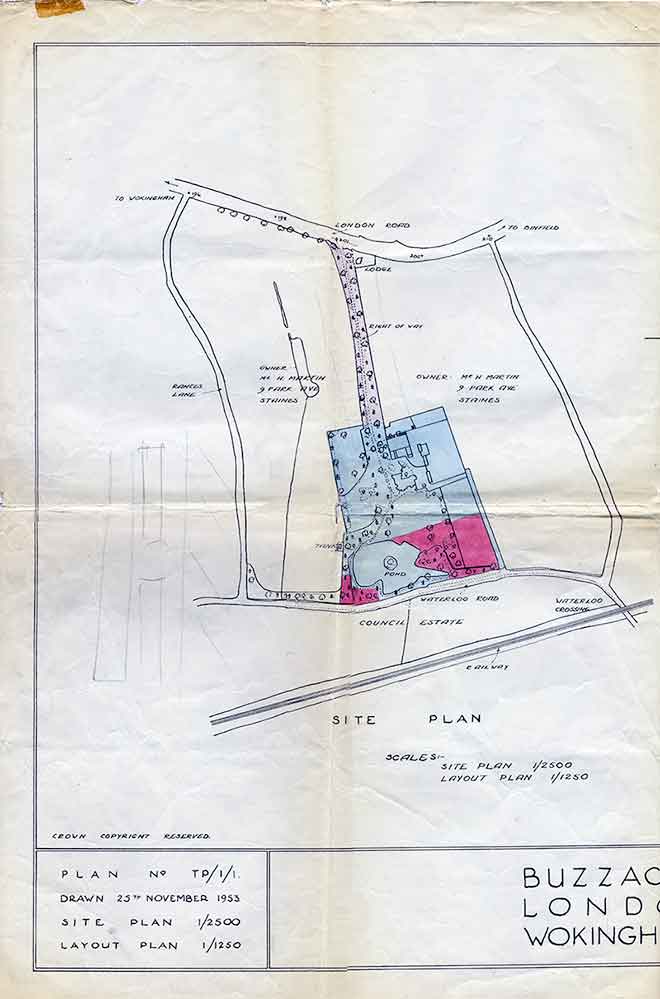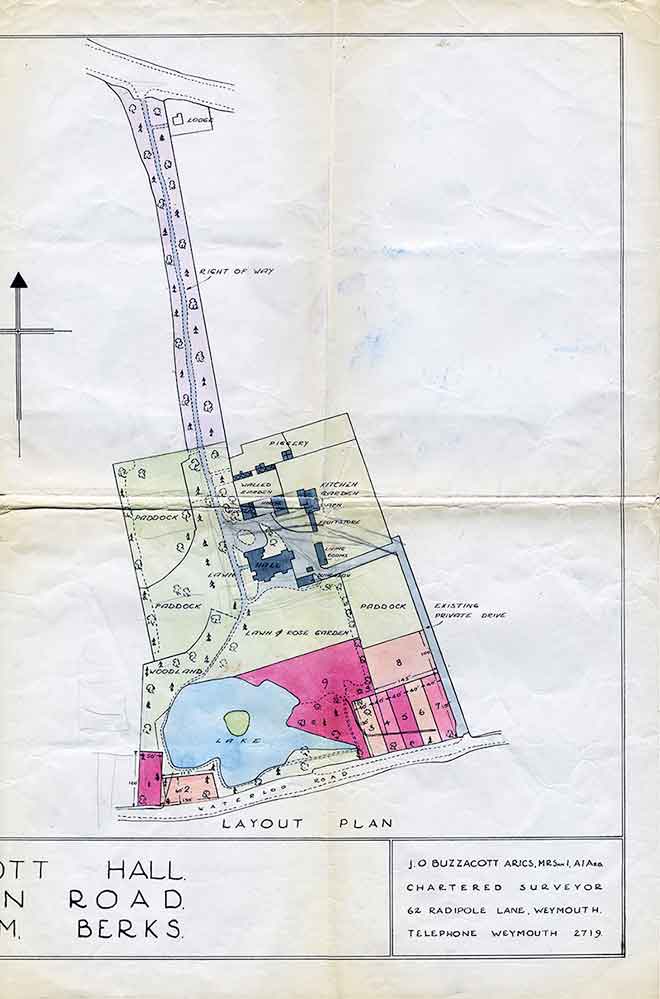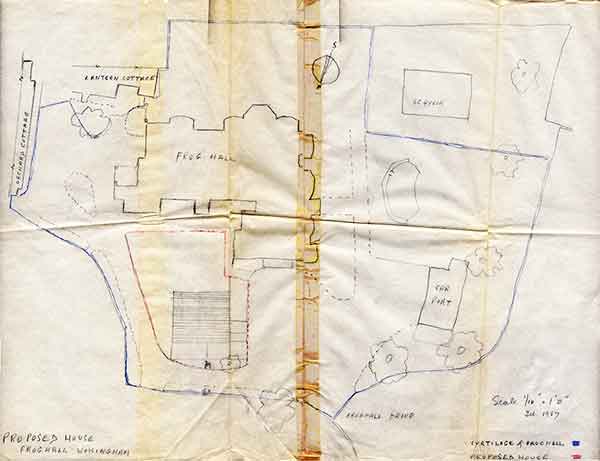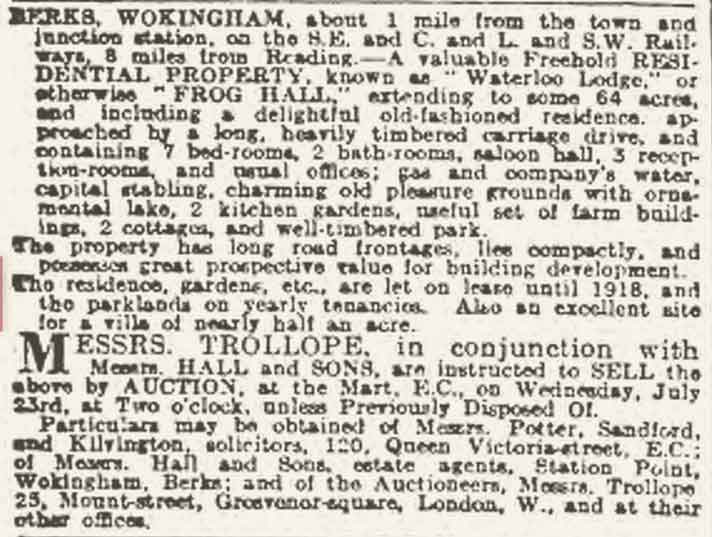The History of Frog Hall Drive
Chris French, May 2020
Introduction
The history of Frog Hall Drive and its houses are of course dominated by the history of Frog Hall. The date of construction of Frog Hall is not known although it has been referred to as Queen Anne in a sale document. Queen Anne was on the throne of England from 1702 until 1714. There have been a number of alterations and additions to the main building. The main entrance was originally on the west side but later on further building added a new front and the entrance was moved to its present position. It is possible to see the different type of architecture where the new front was added on. It is thought the later parts are Georgian. When in the 1970s the hall was converted into twelve flats the servants wing on the east side was extended.
The houses numbered 38/40/42 have had a more unusual history than most of the rest of those in the drive, and Les Roland (No 40) has researched the history of his house in much depth. His findings have contributed greatly to this document, for which I am greatly indebted.
In the 50s there was much legal wrangling when "The Cottage" (No. 40) was kept a separate entity to the hall and the rest of its grounds and not sold as part of the estate. There were many boundary disputes.
Froghall Drive or Frog Hall Drive?
The premise is that there was a house, in a marshy area near where the Three Frogs pub is now - called Frog Hall. The area around it was called Froghall Green (and still is - though successive maps show it further east or west and sometime north or south of the main road!). Whether the house was named after the Green or vice versa is not clear. This house was eventually demolished and the pub created in the same place.
After initially being called Waterloo Lodge for many years, since the 1850's, then Frog Hall and then briefly Buzzacott House, the hall was finally renamed Frog Hall in the 1950's. The name of the drive then became Frog Hall Drive. (Why the pub is called the Three Frogs has yet to be discovered).
In the early days the hall was surrounded by its estate of grounds and fields, bounded to the north by the London Road, to the west and east by Rances Lane and Clay Lane and it went south beyond Waterloo Road. In time the estate itself shrank, leaving just the gardens surrounding the hall and a few adjacent buildings. Eventually these buildings were also sold off, leaving just the hall as we know it today.
Key dates and events
17th Century
13 August 1628
An early mention of our pub, if not our road, appears in this charitable entry: "William Thare, will, 13 August 1628, whereby a rent-charge of £3 3s issuing from three cottages in Denmark Street, and land containing 1 a. 1 r. 11 p. near the 'Three Frogs' in London Road, was granted for distribution amongst six decayed tradesmen, 10s. apiece, and 3s for the expenses of the trustees."
18th Century
1761
The Rocques Survey of Berkshire map shows a building called Froghall and just north west of it is an area called Froghall Green. Co(p)pid Beech Lane is shown (now the London Road). "Froghall" appears on the map roughly where the pub is but the un-named building a little further south is possibly what we NOW call Frog Hall.

19th Century
1815
This is the date of the Battle of Waterloo – and presumably the reason for the name of the Hall for many years.
1817
An "enclosure map" of this year shows the Hall and surrounding area, owned by R. Crabtree.

1818 & 1820
We know at these dates that Richard Crabtree was living in Waterloo Lodge [Ref 1],[Ref 8]. (This is the first use of the name "Waterloo Lodge" that I have found).
14 March 1840
The birth at Waterloo Lodge, Wokingham of a daughter to the wife of John Hulme was announced in the Reading Mercury.
11 July 1840
In an Indenture, Maria Crabtree late of Waterloo Lodge, executor of Richard Crabtree, leased Waterloo Lodge to John Walter II (of Bearwood) for two years.
26 September 1842
An indenture referred to Waterloo Lodge. It appears John Walter II, who was M.P. for Nottingham and who lived at Bearwood, now owned Waterloo Lodge. He died in 1847 and it passed to his wife Mary. In an Indenture of Settlement she appointed a certain James Charles Lettcourt to be a trustee jointly with Alexander Dobie and Thomas Cooke.
12 September 1846
Arthur Fraser Walter (the second son of John Walter III) was born in Waterloo House (as it was sometimes called). In 1894 he inherited the Bearwood Estate on the sudden death of his elder brother (born in March 1846).
1855
We know at this time that Mrs Hulme (a housekeeper ?) was living in Waterloo Lodge [Ref 2].
25 March 1859
In a Reconveyance, between Rev William Pochin Larken and John Walter III of Bearwood, Waterloo Lodge or Waterloo Hall had an area of 193 acres. There was also a reference to other parcels of land. Under this document John Walter paid the Rev. William Larken £6400 as a consideration.
23 October 1867
On a sketch map of this date a different layout was shown for the Hall.

1875
In a Succession Duty on Property in Expentancy, John Walter III inherited Frog Hall from Mary Walter derived from John Walter II in a will dated 9/2/1847. It was occupied by Colonel Guines at a rent of £150 per year but was then sold to Mr William Goodchild for £6000. This was recorded as the mansion house plus 53.3.11 acres of land. Other parcels of land, 16.1.30 acres - James Gale Barford for £1090, 3.1.5 acres - Mr Marshall Pattens Ash for £500, and 72.2.22 acres Sydney Alex Hankey £6400, were sold off at the same time. Thus presumably the original farm was split up.
30 June 1883
An Ordnance Survey map of 6 inches to the mile, based on a survey from 1871-2, shows the building called Waterloo Lodge. The area called Froghall Green (approx. where St Crispins is now) is shown, as is the Three Frogs Public House. The railway is called London and South Western Railway (Staines, Wokingham and Reading Branch).
1887
We know at this time that Samuel Goodchild was living in Waterloo Lodge [Ref 6].

20th Century
31 May 1906
Samuel Holt Lomax made his will and appointed Charles Henry Lomax, John Chadwick Lomax and William Hamilton Alston as executors. Frog Hall, formerly known as Waterloo Lodge was a farm with an area of 54.099 acres. (This is the first use of "Frog Hall" I have found for the building). It stretched from London Road in the north to the railway in the south; Clay Lane was the eastern boundary and Rances Lane the western one. Waterloo Road crossed the farm and there was a drive from the house to it as well as to the main road.
1911
We know at this time that the Barnard family was living at Frog Hall [Ref 4].
1912
An Ordnance Survey map of 23 inches to the mile scale, using an original survey of 1870, revised in 1909, names the building Frog Hall. It showed Waterloo Road and the Waterloo Crossing on the railway line.

06 November 1918
Charles Henry Lomax and William Hamilton Alston sold Frog Hall to James Thomas Sydenham.
13 May 1921
J T Sydenham made his will, with his wife Ada amongst his executors.
08 August 1921
J T Sydenham was last seen alive on this date and was found dead on 22/August/1921 at Easthamstead Wood, Easthampstead.
06 March 1922
Frog Hall was purchased by Vaughan Adrian Stokes, a Captain in the Army, who was a local farmer. It is rumoured that he drowned himself in the pond!
26 July 1927
James Rolt purchased Frog Hall from V A Stokes.
01 October 1930
Charles Etwell had a yearly tenancy from James Rolt. Etwell was a farmer who ran cattle and grew hay in the fields east and west of the drive. He also ran the local milk delivery business.
James Rolt was a Kings Councilor and made Frog Hall his retirement home.
He and his wife Grace had a large establishment with as many as eight servants in the house and a large force of groundsmen. The head gardener lived in the lodge at the top of the drive (now No 2) whilst his second gardener lived in a cottage on the opposite side of London Road. He had previously been the coachman for the Rolts but when they moved to Wokingham they employed a chauffeur who lived with his wife and two sons in the Cottage (now No. 40). For many years two landaus were kept in the garages although never used.
During this time the grounds were well kept. The drive up to London Road was gravel flanked by grassy banks and a profusion of rhododendrons.
The chauffeur's name was Lane and much of this section of information has been supplied by his younger son Frank.30 December 1937
Town Planning Agreement between Richard Lowndes, Charles Medway, Frederick Charles Ihlee and Berkshire County Council.
1938 - 39
First Grace and then James Rolt died and are buried in All Saints churchyard - on the left inside the gate entrance from London Road.
1937
We know at this time that Richard Crabtree was living at Waterloo Lodge. [Ref 3]
14 September 1939
Harmar Ltd bought the property and 53 acres for £5500.
7 March 1940
Permission was granted to W Timothy Donovan to use Frog Hall as a nursing home.
22 April 1940
Harmer Ltd sold Frog Hall and about 10 acres of land to James Cooper Budge and Alice Budge with a right of way from London Road, for £2500. They got a mortgage of £1,650. At that time the grounds included the frontage onto Waterloo Road. They ran a nursing home in Frog Hall, with Donovan as the manager. The sale covenant insisted that they kept the hedges and fences in good order and were not allowed to keep poultry or pigeons.
29 September 1940
The yearly tenancy with Etwell terminated after one year's notice.
7 September 1945
Frog Hall was put up for auction with Watts & Sons by the Budges but did not reach the reserve price.
6 March 1946
The Hall was sold privately by the Budges to James Buzzacott for £8000 (for and as a donation to the Salvation Army Homes) to be known as the Nurse Emily Buzzacott Home in the memory of Miss E Buzzacott. He renamed it Buzzacott Hall and the Salvation Army ran it as an old people's home until they moved out themselves, as they found it too expensive. Somewhere about this time there was an idea to convert Frog Hall into an hotel, but this was turned down because the drive was considered too narrow, if cars were parked in it, for a fire engine to come down it in the event of an emergency.
27 January 1950
The London Gazette announced the death of Edith Marian Butterworth, of Buzzacott Hall.
25 June 1952
The London Gazette announced the death of Alice Sarah Dunn, of Buzzacott Hall. This lady, and the one before, were presumably residents of the old people's home.
Buzzacott Hall Plans 1953


14 September 1954
Buzzacott Hall and the remaining land, except for "The Cottage", was auctioned by Foster & Cranfield, Martin & Pole. It was freehold with vacant possession.
22 November 1954
J Buzzacott completed the sale of Frog Hall and the land, including the Barn and buildings (now 42 Froghall Drive) etc, to Peter Sidney Telling. Along with Frog Hall (then called Buzzacott Hall) Telling bought an additional seven acres of surrounding land. Buzzacott retained "The Cottage", now 40 Froghall Drive, for himself and carried on living there with his housekeeper Betty Miller.
You can view 1954 photos of the Drive here.
24 February 1956
Telling sold some land to Ian and Margaret baker, where "Nether Staples" now is.
23 July 1956
Telling sold the Hall to Harry and Florence Lucy Charlesworth.
1 November 1956
There is a lengthy report on the many aspects of a dispute between Buzzacott and Telling over their exact boundaries, rights of way, fences, drains etc.
1 May 1962
We know at this time that the Charlesworths were living in Frog Hall [Ref 7].
February 1967
Plans were drawn up for a new house, to be built immediately in front of the hall. This proposal was presumably scrapped or permission was refused.

1968
We know at this time that the Charlesworths were living in Frog Hall [Ref 9].
27 December 1970
James Buzzacott died. His address in the Gazette was given as "Buzzacott House, 40 Froghall Drive, Wokingham" and his occupation as a Retired Estate Agent.
19 April 1971
The Charlesworths sold the Hall to Den Hill Securities Ltd for £16,500 and presumably the rest of the land was split off.
31 July 1971
The National Westminster Bank (as executors of J Buzzacott) passed 40 Froghall Drive to Betty Miller (previously J Buzzacott's housekeeper).
19 May 1972
The Hall was sold to Bachittar Singh Hothi, a director in several property companies, for £49,500 and he extended the servants quarters end and subdivided the whole into twelve leasehold flats.
Other relevant facts
Buckhurst Grove
After 1954, when Telling bought the Hall and grounds he built the houses in Buckhurst Grove but was unable to sell them until he provided a private footpath from the blind end of Buckhurst through to Froghall Drive so that the residents had easy access up Froghall Drive to the bus stop in London Road near the Three Frogs. Telling had also by then sold Frog Hall to the Charlesworths who insisted that there was a gate at each end of the footpath and the residents of Buckhurst be provided with a key. This footpath and gates form part of the property of No 46 Froghall Drive.
Over the years this footpath and in particular the locked gates fell into disrepair but were reinstituted by the owner. However when he died his widow had the locks removed as she found it difficult to open them so that she could get through to Waterloo Road and the Rances Lane shops. Unfortunately this meant that all and sundry could make their way through from Waterloo Road and security became a problem in and around Frog Hall and the blind end of Froghall Drive. (2004) All being well the owner of 42 (Alan Scott) hopes to re-establish the lock on at least one of these gates when the new owner of the property to the west of the footpath improves the fencing and gates on his land.
Land registry maps of 1964 & 65 show this footpath but 46 Froghall Drive is not marked, as it was not built until later.
Land registry maps dated 1973 show both the footpath and 46 Froghall Drive. It ends on the land leading from the right of way alongside Frog Hall leading to 46 Froghall Drive. Thus people coming from Buckhurst would walk over land that presumably belonged to 46 Froghall Drive.
38/40 Froghall Drive
North of 40 Froghall Drive was a walled garden, which also contained a glass house. Mr. J D Andrews purchased this area plus other land from Telling and he then built what is now 74 Waterloo Road. Later on Andrews built a house within the walled garden and subdivided this plus the barn from the original parcel. The Andrews then moved into this house (Nether Staples 38 Froghall Drive). A further house was also built, again accessed from the private road off Waterloo Road.
For £150 a strip of land 12ft by 41 ft was sold by the owner of 40 Froghall Drive to the owner of No. 38, Mr Andrews, to give him a vehicular access from his house to Froghall Drive. However a covenant was applied so that no further building on 38's land except for a one-storey garage without the written consent of the owner of 40 Froghall Drive. At this time the barn was part of 38 Froghall Drive and used as a general-purpose store and garage. The vehicular access was up the private road from Waterloo Road.
42 Froghall Drive
When Tilling built Buckhurst Grove he brought his foreman carpenter George Tapsel with him as general foreman. He moved into and eventually purchased a building, which was line of rooms to the east of the Hall. These rooms were originally sleeping quarters for the servants of visitors to the Hall. At one time a generator and storage accumulators were installed in the end room to provide electricity to the hall and the cottage. Eventually these were removed when the buildings were connected to the mains supply. Tapsel also purchased the old fruit storage building with the chimney stack at one end, which he used as a general (junk) store.
Tapsel carried many alterations and additions to the rooms and lived there with his wife and three sons for many years. This became 42 Froghall Drive. When he died in 1987 he left the house to his wife and the store to two of his grandsons (sons of the two of his sons who were still in the UK - the third son had already emigrated to Perth WA). Eventually his wife who had difficulty moved into sheltered accommodation and the house stood empty for a long time. In 1995 it was sold to a developer, knocked down and a four-bedroom house built in its place. At the same time the storage sheds were recombined with the property and used by the builder as a store etc. However the first purchaser of the new house did not want the store and eventually it was sold off and was split into two. The end nearest the barn was rebuilt and became a garage for it. The other part was purchased by the owner of the house on the private road behind thus giving him access to the right of way alongside Froghall Drive.
The Lake
Early maps, from 1883 at least, show that the grounds of the Hall included a Fish Pond, with an island. A lawn led down to the lake from the Hall. This is now in the grounds of No 70, Waterloo Road.
Frog Hall
Here is a list of the owners of Frog Hall and you can find more historic maps here.
Internet search results
Google Books
It is possible to search a vast number of online Google Books and the following items have come to light. They indicate who was living in the hall at certain times.
[Ref: 1] Tales & Poems – Mrs Stanley – 1818 Richard Crabtree of Waterloo Lodge was a subscriber (in those days subscribers paid a small sum that helped towards the publication cost of books they would like to encourage and their names featured prominently at the beginning of the book).
[Ref: 2] Universal Masonic Library - Volume 10 – Robert Macoy – 1855 – Mrs Hulme of Waterloo Lodge was a subscriber.
[Ref: 3] Records of the parish church and parish of Wokingham, Berks – Bertram Long – 1937 – "Richard Crabtree lived at Waterloo Lodge, now called Froghall. He died in 1836".
Wokingham remembers
This website was created to collect information about those from the area involved in, or affected by, the Great War (but has now extended its scope).
[Ref: 4] A page about Dudley Barnard, who attended Wellington College and died on 10 February 1915, records that in 1911 his parents were living at Frog Hall. The 1911 Census Return for Frog Hall also shows it was occupied at that time by a Lionel Barnard, a solicitor, his wife, 3 guests and 4 servants.
[Ref: 5] A page about Samuel Lomax, who died on 10th April 1915, says his probate register entry has his address as Froghall, though he did not die there.
Miscellaneous finds
[Ref: 6] William Goodchild was a churchwarden, magistrate and finally Mayor of Wokingham in 1887. He lived at Waterloo Lodge.
[Ref: 7] As at 1st May 1962, the Berkshire Archaeological Society has a list of members, which included Major H and Mrs Charlesworth, of Frog Hall, Wokingham.
[Ref: 9] A Finnish web site, recording the ownership and pedigrees of racehorses, shows that in 1968 Major Charlesworth, of Frog Hall, owned a stallion called Cedar Lucifer, stabled near Ringwood.
The London Gazette
Searches of the Gazette show the name, date of death and last address of a number of people. Searching for Buzzacott finds two ladies and James Buzzaccott himself.
The London Standard
On June 25, 1913, an announcement was made regarding the auction of the Hall, as a freehold property. However, we don't know the outcome of the auction. It mentions that property is let on lease until 1918, which is when Lomax and Alston sold it to J T Sydenham.

Leicestershire Record Office
An entry notes:
Richard Crabtree, Waterloo Lodge, Wokingham, Bucks
Encloses all the printed agreements, and advises Sir Henry not to abate any rents without careful investigation.
[Ref: 8] Enclosed: Bill to Sir Henry Halford from Richard Crabtree, 1820. £84 for valuing and letting farms at Wistow etc.
Priest Avenue
Priest Avenue is named after Albert Priest, Mayor of Wokingham in the 1930s.
The Three Frogs
The Three Frogs was first licensed as a pub in 1770, although the cottages that are now the heart of the building are much older.